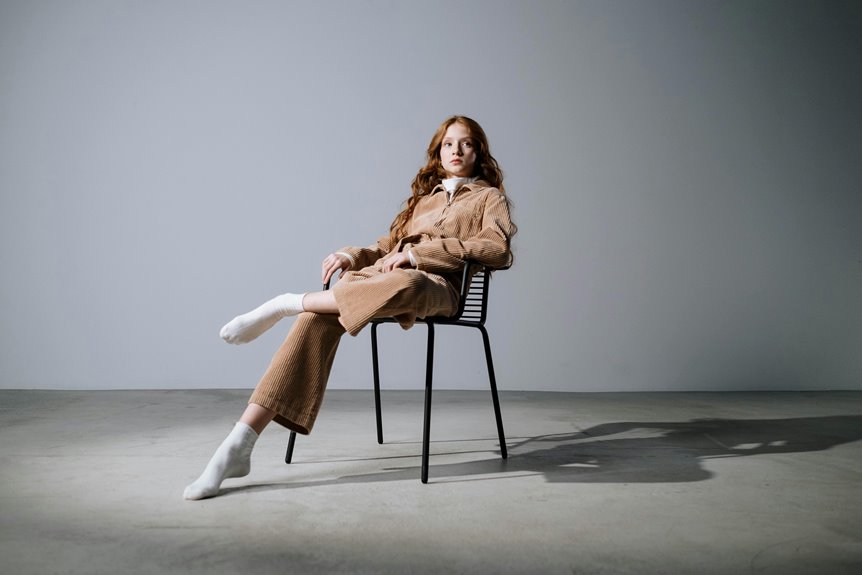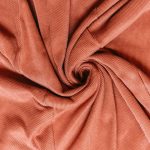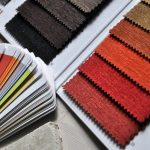To master corduroy, start by choosing the right type—pinwale for shirts or wide-wale for jackets. Prewash and cut all pieces with the nap running the same way to keep its plush texture smooth. Use sharp needles and longer stitches to avoid puckering while sewing. Care for your garments by washing inside out with mild detergent and air drying. Once you nail these basics, you’ll discover clever ways to style and use corduroy in fashion and home decor.
Table of Contents
Key Takeaways
- Select corduroy type and wale size based on project needs, balancing texture, weight, and flexibility for desired garment or decor effect.
- Prewash and cut corduroy with nap running in the same direction to maintain fabric texture and prevent shrinkage during sewing.
- Use sharp needles and longer stitch lengths to avoid puckering, and press seams gently to preserve corduroy’s plush feel.
- Pair corduroy with complementary textures and rich colors to enhance its tactile appeal in fashion and home decor.
- Incorporate corduroy in upholstery, cushions, and soft furnishings to add warmth, durability, and visual interest to spaces.
Understanding Different Types of Corduroy
Corduroy comes in several distinct types, each defined by the width and texture of its cords or “wales.” When you learn to identify these variations, you can choose the perfect fabric for your project, whether it’s a sleek pair of pants or a cozy jacket.
You’ll find fine-wale corduroy, featuring narrow, closely spaced ribs that give a smooth, elegant look. Wide-wale corduroy, on the other hand, has broader ribs, offering a chunkier, more casual vibe.
Pinwale corduroy presents the thinnest ribs, perfect for lightweight, soft garments. Some corduroys even combine texture with stretch or different fiber blends, adding versatility.
Recognizing these types helps you appreciate how corduroy’s structure influences appearance, feel, and durability, setting a solid foundation before picking your fabric.
Selecting the Right Corduroy for Your Project
When choosing corduroy for your project, consider the type of corduroy and its wale size to match your design needs.
Pay close attention to fabric weight, as lighter options work well for shirts while heavier ones suit jackets and pants.
Picking the right combination guarantees your finished piece feels comfortable and looks great.
Corduroy Types Overview
Choosing the right fabric can make or break your project, especially with a material as versatile as corduroy. You’ll find several types, each suited for different uses.
Standard corduroy features wide wales, offering a bold texture perfect for jackets or pants. Pinwale corduroy, with its narrow ribs, feels softer and works well for shirts or dresses.
Bedford cord, a durable cousin, has a subtle rib and is great for workwear. Stretch corduroy blends in elastane, giving you flexibility for fitted garments.
Ultimately, velveteen mimics corduroy’s texture but with a smoother finish, ideal for softer apparel.
When choosing, consider how each type’s texture and look align with your project’s purpose and style.
Fabric Weight Considerations
Although fabric weight might seem like a minor detail, it plays an essential role in determining how your corduroy project will turn out.
When choosing corduroy, consider whether you need lightweight, midweight, or heavyweight fabric. Lightweight corduroy works well for shirts and dresses, offering comfort and ease of movement. Midweight is ideal for pants and skirts, providing durability without bulk. Heavyweight corduroy suits jackets and upholstery, giving structure and warmth.
Don’t forget to check the fabric’s thickness and wale count, as finer wales generally mean a lighter fabric. By selecting the right weight, you guarantee your project fits well, feels right, and lasts longer.
Always match the fabric weight to your garment’s purpose for the best results.
Preparing Corduroy Fabric for Sewing
Before you start sewing, make sure to prewash your corduroy to prevent shrinkage later on.
When cutting, pay close attention to the fabric’s nap so all pieces face the same direction. Managing these details will help your project turn out crisp and professional.
Prewashing Corduroy Tips
When you’re preparing corduroy fabric for sewing, prewashing is crucial to prevent shrinkage and color fading later on.
You’ll want to treat your fabric gently to preserve its texture and vibrant hues. Here’s how you can do it right:
- Wash corduroy separately in cold water to avoid dye transfer and maintain color richness.
- Use a mild detergent to protect the fabric’s soft pile from harsh chemicals.
- Avoid tumble drying; instead, air dry your fabric to prevent crushing the pile and maintain its plush feel.
- After washing, lightly press the fabric with a warm iron on the wrong side to remove wrinkles without flattening the ribs.
Following these tips guarantees your corduroy stays beautiful and lasts through every project you create.
Cutting Corduroy Properly
Since corduroy has a distinctive ribbed texture, cutting it properly requires extra attention to direction and alignment.
Lay your fabric flat on a clean surface, smoothing out any wrinkles without stretching it. Align your pattern pieces so the ribs run consistently, usually vertically, to maintain a uniform look.
Use sharp scissors or a rotary cutter to achieve clean edges, avoiding frayed or uneven cuts. Pin your pattern securely to prevent shifting, and cut slowly to follow the grain accurately.
Remember to cut all pieces in the same rib direction to keep the garment’s texture consistent. Taking these steps guarantees your corduroy pieces fit together neatly, setting a strong foundation before you start sewing.
Managing Fabric Nap
Managing the fabric nap is essential to guarantee your corduroy pieces look smooth and consistent after sewing. The nap’s direction affects how light reflects off the fabric, so you need to cut all pattern pieces with the nap running the same way.
Before cutting, run your hand over the fabric to feel the nap’s orientation. Pin pattern pieces carefully, aligning the nap. When sewing, use a walking foot to prevent shifting. Press seams gently, always in the direction of the nap, to avoid crushing the pile.
Remember:
- Consistent nap direction keeps colors uniform and vibrant
- Handling fabric carefully preserves its soft texture
- Aligning nap enhances the garment’s professional finish
- Gentle pressing prevents damaging the corduroy’s surface
Mastering nap management boosts your confidence and results!
Essential Sewing Techniques for Corduroy
Sewing corduroy demands a few key techniques to make certain your projects turn out polished and durable.
First, use sharp needles—size 90/14 or 100/16—to pierce the thick fabric cleanly and avoid skipped stitches. Adjust your machine’s tension slightly looser to prevent puckering.
When cutting, lay your fabric flat and cut with the nap running in the same direction for all pieces to make certain uniform color and texture. Pin carefully, placing pins perpendicular to the seam to keep the ridges aligned.
Use a longer stitch length, around 3.0 to 3.5 mm, to reduce fabric bunching.
Finally, press seams gently with a steam iron and a pressing cloth, avoiding heavy pressure that could crush the pile.
These steps help you master corduroy sewing with ease and precision.
Caring for Corduroy Garments and Projects
While corduroy’s textured surface adds charm and durability to your garments, it also requires thoughtful care to maintain its appearance.
Corduroy’s unique texture brings both charm and durability, demanding careful maintenance to keep it looking its best.
To keep your corduroy looking vibrant and soft, you’ll want to handle it gently and avoid harsh treatments. Here’s how you can care for your corduroy pieces:
- Wash corduroy inside out on a gentle cycle to protect the pile.
- Use cold water and mild detergent to prevent fading and stiffness.
- Avoid high heat when drying; air drying or low heat prevents shrinkage.
- Brush the fabric with a soft clothes brush to restore its plush texture.
Styling Tips to Showcase Corduroy Textures
Taking good care of your corduroy guarantees it stays soft and vibrant, making it easier to highlight its unique texture in your outfits.
To showcase corduroy’s rich texture, pair it with smooth fabrics like silk or cotton to create contrast. Choose simple silhouettes that let the fabric’s ridges stand out without overwhelming your look.
When selecting colors, opt for earthy tones or deep hues that emphasize corduroy’s natural warmth. Accessorize minimally to keep the focus on the fabric.
For layering, try a corduroy jacket over a crisp shirt or a lightweight sweater to add dimension.
Finally, pay attention to lighting—natural light enhances corduroy’s tactile appeal best, so wear your pieces where they can shine.
These styling tips will help you make the most of corduroy’s distinctive charm.
Creative Ideas for Using Corduroy in Home Decor
If you want to add warmth and texture to your living space, corduroy offers a unique fabric choice that goes beyond fashion. Its soft, ribbed texture instantly cozy-fies any room, making it perfect for home decor projects.
You can bring character and comfort with corduroy in unexpected ways. Try using it to upholster cushions or armchairs for a plush, inviting feel. Corduroy curtains filter light gently, adding softness without sacrificing style.
Even small accents like throw pillows or table runners create a tactile contrast that draws the eye. Here are a few creative ideas to inspire you:
- Reupholster an old chair with rich, deep-colored corduroy for a vintage touch
- Sew corduroy pillow covers to add warmth to your sofa
- Use corduroy fabric to craft soft lampshade covers for subtle texture
- Create cozy bed throws blending corduroy with complementary fabrics
Corduroy transforms your space into a comforting haven you’ll love.
Frequently Asked Questions
Can Corduroy Be Used for Upholstery on Outdoor Furniture?
You shouldn’t use corduroy for outdoor furniture because it absorbs moisture and fades in sunlight. Instead, choose weather-resistant fabrics designed for outdoor use to keep your furniture looking great and lasting longer in any weather.
How Does Corduroy Fabric Behave in Different Climates?
Imagine a knight’s armor adapting—corduroy breathes well in dry climates but traps moisture in humid ones. You’ll find it warm in winter but risk mildew in damp weather, so protect it accordingly to keep it lasting.
Are There Eco-Friendly or Sustainable Options for Corduroy Fabric?
You can find eco-friendly corduroy made from organic cotton or recycled fibers. These options reduce environmental impact and use less water and chemicals, so you’re supporting sustainability while enjoying that cozy, textured fabric feel.
What Historical or Cultural Significance Does Corduroy Hold?
You’ll find corduroy carries rich history, often linked to working-class attire and British fashion. It’s valued for durability and warmth, symbolizing practicality and style across cultures, evolving into a timeless, versatile fabric loved worldwide.
Can Corduroy Be Combined With Other Fabrics for Mixed-Media Projects?
You know what they say, “variety is the spice of life.” You can definitely combine corduroy with other fabrics in mixed-media projects. Its texture pairs well with smoother materials, adding depth and contrast to your creations.
- Does Chiffon Fabric Stink - July 15, 2025
- Does Chiffon Fabric Affect the Economy - July 15, 2025
- Does Cotton Fabric Have a Nap - July 15, 2025







